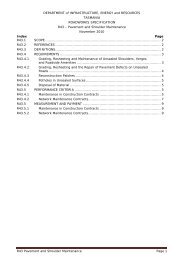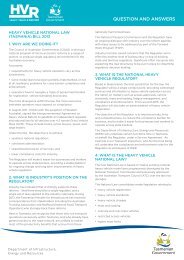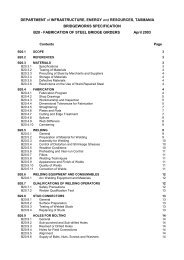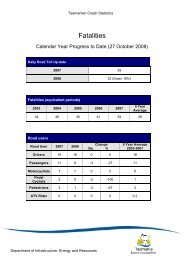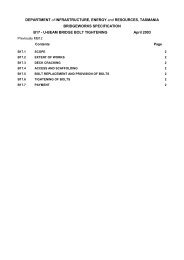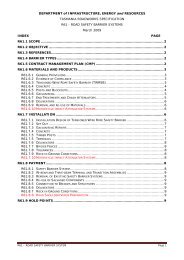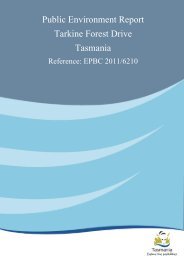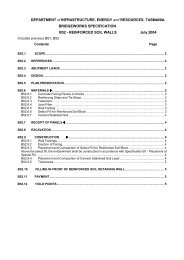Traffic Signs and Pavement Marking - Transport
Traffic Signs and Pavement Marking - Transport
Traffic Signs and Pavement Marking - Transport
You also want an ePaper? Increase the reach of your titles
YUMPU automatically turns print PDFs into web optimized ePapers that Google loves.
DEPARTMENT of INFRASTRUCTURE, ENERGY <strong>and</strong> RESOURCESSTANDARD BRIEF FOR PROFESSIONAL SERVICEST10 TRAFFIC SIGNS AND PAVEMENT MARKINGCONTENTSPageT10.1 SCOPE ...........................................................................................................1T10.2 DESIGN STANDARDS...................................................................................1T10.3 SPECIFIC REQUIREMENTS .........................................................................1T10.4 HOLDPOINTS AND DELIVERABLES...........................................................2APPENDIX T10 A .........................................................................................................2Recommended Practice for Installation <strong>and</strong> Maintenance of <strong>Pavement</strong> <strong>Marking</strong>son State Roads........................................................................................................ 31. INTRODUCTION.......................................................................................................32. POLICY ....................................................................................................................33. PRODUCT SELECTION ...........................................................................................44. REMARKING MANAGEMENT .................................................................................45. ROAD MARKING POLICY SUMMARY TABLE.......................................................56. ROAD MARKING GUIDELINES...............................................................................5St<strong>and</strong>ard Brief for Professional Services Issue No. 6February 2005
TRAFFIC SIGNS AND PAVEMENT MARKINGPage 1 of 2T10.1 SCOPEThis St<strong>and</strong>ard Brief sets out requirements for signing <strong>and</strong> pavement marking of roads.T10.2 DESIGN STANDARDSSigning <strong>and</strong> pavement marking shall be in accordance with Australian St<strong>and</strong>ard AS1742:Manual of Uniform <strong>Traffic</strong> Control Devices. <strong>and</strong> DIER Technical Advice Notices.Regulatory <strong>and</strong> warning signs, other than speed limit signs, shall be:• Size A as repeater signs in speed zones of 60 km/h or less;• Size B in speed zones between 50 km/h <strong>and</strong> 100 km/h;• Size C in speed zones of greater than100 km/h.T10.3 SPECIFIC REQUIREMENTS<strong>Pavement</strong> marking shall be provided to meet the requirements of Tables T10.1 <strong>and</strong> T10.2.Level 1 material shall be installed for intersection markings in urban areas on asphaltsurfacing.RRPM's will not normally be installed where street lighting exists.No audible edgelines shall be installed within 200 metres of residences.Appendix T10 A details DIER linemarking policy <strong>and</strong> provides guidance for product selection.Table T10.1 – <strong>Pavement</strong> <strong>Marking</strong> RequirementsRoad CrossSectionMaterialEdgeline to be provided RRPM #Non-audible Audible* centreline edgelineA1 Level 1, 2 or 3 Yes Yes Yes YesB1 Level 1, 2 or 3 Yes Yes Yes YesC1 Level 2 or 3 Yes No Yes YesD1 Level 2 or 3 Yes No Yes YesD2 Level 2 or 3 Yes No Yes NoE1 Level 2 or 3 Yes No Yes NoF1 + F2 None None None None None*Audible to be specified where crash history indicates it is required for safety as agreed withthe Principal’s Representative.# RRPMs should not be installed in areas where adequate street lighting is present.Table T10.2– <strong>Pavement</strong> <strong>Marking</strong> PerformanceLevelMaterial to last1 Durable More than five years2 St<strong>and</strong>ard More than two years3 Temporary Up to two yearsSt<strong>and</strong>ard Brief for Professional Services Issue No. 6February 2005
TRAFFIC SIGNS AND PAVEMENT MARKINGT10.4 HOLDPOINTS AND DELIVERABLESPage 2 of 2There are no Holdpoints or Deliverables in this St<strong>and</strong>ard <strong>Traffic</strong> <strong>Signs</strong> <strong>and</strong> <strong>Pavement</strong><strong>Marking</strong> Brief.APPENDIX T10 ARecommended Practice for Installation <strong>and</strong> Maintenance of <strong>Pavement</strong> <strong>Marking</strong>son State RoadsSt<strong>and</strong>ard Brief for Professional Services Issue No. 6February 2005
T10 APPENDIX ARecommended Practice for Installation <strong>and</strong> Maintenance of <strong>Pavement</strong> <strong>Marking</strong>s on StateRoads1. INTRODUCTIONMany of the crashes reported on the State road network are single vehicle accidents on rural roadswhere the driver has lost control <strong>and</strong> left the carriageway. Road markings provide guidance todrivers that help them stay on the road. It is considered that enhanced delineation could beeffective at reducing the number <strong>and</strong> severity of crashes. Obviously, such a change would havefinancial implications <strong>and</strong> would need to be supported with additional funding.This document sets out a revised policy for pavement markings on State roads – what should beprovided on which roads. It also discusses practice – what type of materials should be used <strong>and</strong>how frequently they should be maintained.2. POLICYRoad markings are to be provided in accordance with:• Technical Advice Sheet No.7 – Centre of the road markings; <strong>and</strong>• AS1742, Part 2 – <strong>Traffic</strong> control devices for general use.Roads with a width of 5.5 metres or greater should be provided with:• centre of the road markings.MINIMUM LANE WIDTHS: 2.75 METRESIt has been estimated that 88% of the State road network is 5.5 metres or wider.Roads with a width of 6.5 metres or greater should be provided with:• centre of the road markings;• RRPMs on the centreline; <strong>and</strong>• edgeline markings with at least 0.1 metres outside the edgeline.MINIMUM LANE WIDTHS: 3.0 METRESIt has been estimated that 49% of the State road network is 6.5 metres or wider.It is noted that RRPMs on roads that are snow-ploughed need to be designed accordingly.The need for RRPMs is reduced where there is street lighting <strong>and</strong> the need for edgeline is reducedwhen there is kerbing.The Category 1 <strong>and</strong> 2 Highways <strong>and</strong> dual carriageways with no street lighting should be providedwith:• centre of the road markings;• RRPMs on the centreline;• edgeline markings; <strong>and</strong>• RRPMs outside the edgeline.St<strong>and</strong>ard Brief for Professional Services Issue No. 6February 2005
T10 APPENDIX AThe need for audible markings will be identified on a site-by-site basis based on crash history.Audible markings are considered a countermeasure where inattention <strong>and</strong> falling asleep areleading to crashes.3. PRODUCT SELECTIONThere are four marking materials available: water-based paint, extruded thermoplastic, sprayedthermoplastic, splatter thermoplastic, cold applied plastic <strong>and</strong> solvent-based paint,.• Water based paint is now specified in three application typeso Temporary. A 200-micron film using st<strong>and</strong>ard beads that should last about a year. Initialretro-reflectivity should exceed 150 mcd/lux/m 2 with a residual at replacement of 100mcd/lux/m 2 . This has been our st<strong>and</strong>ard marking.o St<strong>and</strong>ard. A 300-micron film using larger beads that should last 2 to 3 years. Initial retroreflectivityshould exceed 200 mcd/lux/m 2 with a residual at replacement of 100 mcd/lux/m 2 .o Durable A 300-micron film using a durable resin <strong>and</strong> larger beads which should last 4 to 6years. Initial retro-reflectivity should exceed 300 mcd/lux/m 2 with a residual at replacementof 120. This may replace thermoplastic for longitudinal marking on high use roads. It isalso suitable as an initial marking on reseal sites.• Extruded thermoplastic is a high cost product <strong>and</strong> some recent experiences withapplication have been less that satisfactory. It is suited to longitudinal marking where highdurability is required. Thermoplastic is best suited for audible tactile markings on high trafficvolume roads, intersections <strong>and</strong> for transverse markings. Initial retro-reflectivity shouldexceed 200 mcd/lux/m 2 with a residual at rejuvenation or replacement of 80.• Splatter thermoplastic is a fairly recent innovation that has not been trialled in Tasmania.It may find use in urban lane line marking as it reputedly performs well in wet conditions.• Spray thermoplastic is a fairly recent innovation but Field Operations staff report that trialsof its use in Tasmania have been unsuccessful <strong>and</strong> there are no plans to continue its use.• Cold Applied Plastic has been trialled interstate <strong>and</strong> is an effective long life (7 to 10 year)product. A methyl methacrylate product that provides a flexible film with good durability <strong>and</strong>excellent skid resistance when bauxite aggregate is added. A wide range of colours isavailable. Best used for chevrons, school on road marking, arrows, intersection thresholds,coloured cycle lanes <strong>and</strong> on road numerals or symbols. Excellent for areas where skidresistance is imperative. May need washing to maintain colours from time to time.• Solvent-based paint has been found to have poorer performance than water based paint<strong>and</strong> there are also environmental issues associated with its use. It is no longer used unlesstemporary markings are required in poor weather conditions. Other temporary measuresmay be more appropriate than solvent-based paint.4. REMARKING MANAGEMENTUnder the Southern Maintenance contract the specification calls for the markings to be maintainedwhen they are ‘worn’ or ‘ineffective’. These terms are subjective <strong>and</strong> difficult to enforce. The retroreflectivityof markings can be measured with an instrument <strong>and</strong> future contract specifications willbe based on such measurements. However, there is also the issue of what proportion of themarkings have to be defective before a whole section is replaced.St<strong>and</strong>ard Brief for Professional Services Issue No. 6February 2005
T10 APPENDIX AUnder the northeast <strong>and</strong> northwest contracts the Department identifies which roads it wantsremarked each year. Roads are marked with water-based paint <strong>and</strong> have been renewed eitherannually or every two years.In future it should be more cost effective to run period contracts for linemarking independent of theMaintenance Contract, as is done for the urban line marking. The remarking frequency should bedetermined by the performance of the marking. If retro-reflectivity is measured for the new line, asrequired by the specification, its life can be predicted <strong>and</strong> that prediction can be verified, ormodified, by periodic performance measurements. The aim is to retain retro-reflectivity above 100mcd/lux/m 2 that is considered to be an effective line performance measure.5. ROAD MARKING POLICY SUMMARY TABLEThe following st<strong>and</strong>ard longitudinal lines shall be applied to State roads:Sealed Road Width Type of <strong>Marking</strong> Road Cross SectionRoads with a width of 5.5metres or greaterRoads with a width of 6.5metres or greaterCategory 1 or 2 <strong>and</strong> dualcarriageway highways with nostreet lightingCentre of the road markingsCentre of the road markings;RRPMs on the centreline; <strong>and</strong>Edgeline markingsCentre of the road markings;RRPMs on the centreline;Edgeline markings; <strong>and</strong>RRPMs outside the edgeline.E1D1, D2A1, B1, C16. ROAD MARKING GUIDELINESMaterial SelectionType of <strong>Marking</strong>sSituationTemporaryTemporaryRegularRegularDurableDurableExtruded ThermoplasticExtruded ThermoplasticExtruded ThermoplasticExtruded ThermoplasticCold Applied PlasticCold Applied Plastic<strong>Pavement</strong>s due for reseal or remarking within 2 yearsLocal repairs following patchingRoutine markings for Category 3, 4 & 5 roadsUrban intersection marking for traffic 5,000 vpdurban transverse lines in traffic >5,000 vpdurban road markings needing long life <strong>and</strong> skid resistanceColoured lanes or on road patches symbols or numeralsSt<strong>and</strong>ard Brief for Professional Services Issue No. 6February 2005
T10 APPENDIX ALine Remarking FrequencyType of <strong>Marking</strong>s Initial retro-reflectivity Frequency (months)Temporary 120 mcd/lux/m 2 12Temporary 200 mcd/lux/m2 24St<strong>and</strong>ard 150 mcd/lux/m 2 24St<strong>and</strong>ard 250 mcd/lux/m 2 36St<strong>and</strong>ard >300 mcd/lux/m 2 42Durable 250 mcd/lux/m 2 48Durable 300 mcd/lux/m 2 60Durable >350 mcd/lux/m 2 72Thermoplastic – audio 200 mcd/lux/m 2 60Thermoplastic urban long 200 mcd/lux/m 2 48Thermoplastic urban transverse 200 mcd/lux/m 2 36Cold Applied Plastic 200 mcd/lux/m 2 72 +Audible tactile thermoplastic may be refreshed with a temporary line over the top provided the lineis still functional as an audible tactile warning.Wear rates <strong>and</strong> reduction in retro-reflectivity are affected by lane widths, alignment of the road,weather, percentage of trucks, <strong>and</strong> s<strong>and</strong> application to icy roads.However the above values are indicative of the expected life.ReferencesTechnical Advice Sheet No.7 – Centre of the road markingsSt<strong>and</strong>ard Brief for Professional Services, Section T10 <strong>Traffic</strong> <strong>Signs</strong> <strong>and</strong> <strong>Pavement</strong> <strong>Marking</strong>St<strong>and</strong>ard Specification Roadworks R64 <strong>Pavement</strong> <strong>Marking</strong>St<strong>and</strong>ard Specification Roadworks R65 Road Furniture MaintenanceSt<strong>and</strong>ard Brief for Professional Services Issue No. 6February 2005



